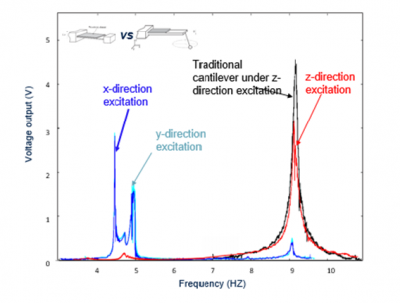Piezoelectric transducers can be used to harvest ambient energy into usuful electricity, which is one of the topics we investigate at DSCL. Existing studies on multi-directional energy harvesting typically use multiple cantilevers. We develop a new sstem that can harvest vibratory energy of excitations from an arbitrary direction with only one cantilever. The design consists of a traditional piezoelectric cantilever with a pendulum attached to the tip. By utilizing the nonlinearity coming from the pendulum motion in 3-dimensional space coupled with the beam bending vibration, with proper parametric combinations we can induce resonances of beam bending motion based on excitations that are perpendicular to the z-direction.

The underlying physics of energy interchange between the beam bending motion and pendulum motion is based on internal resonance. In one cycle of the pendulum resonant motion where the pendulum moves forward and backward, the projection of the acceleration to the z-axis due to pendulum motion periodically varies two cycles. Note that the beam bending motion is sensitive towards the z-direction acceleration. A primary resonance of beam vibration is induced, when the natural frequency of beam vibration is twice of that of the pendulum motion. In such a situation, the vibration energy in the horizontal direction can be effectively harvested by the beam vibration.
A benchmark example structure is analyzed and compared to a traditional cantilever. As can be observed, the traditional cantilever performs optimally under z-direction excitation only. Meanwhile, the cantilever-pendulum system can yield efficient power output under excitations in x-, y-, and z-directions. The maximum voltage output under x– and y-direction excitation (3.01 V) is slightly lower than that under z-direction excitation (3.29 V). Owing to the saturation nonlinearity, under this specific acceleration level the maximum voltage output of the cantilever-pendulum is not as high as that of the traditional one (4.67 V). However, it is worth emphasizing that the proposed multi-directional energy harvester has the unique feature of harvesting energy from the x– and y-direction excitations essentially as efficient as from the z-direction.
